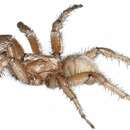en
names in breadcrumbs


Members of the mygalomorph trapdoor spider family Euctenizidae capture prey at the entrance of a burrow they dig and cover with a silk-and-soil trapdoor. This group of spiders was previously treated as a subfamily within the family Cyrtaucheniidae, which is now widely recognized as polyphyletic. Removing the former euctenizines and treating them as a distinct family is one of several changes that have been made (or are likely to be made) to develop a taxonomic treatment of mygalomorph spiders (trapdoor spiders, tarantulas, and their relatives) that better reflects their evolutionary relationships.
The euctenizines were included in the family Ctenizidae until Raven (1985) named the group as a subfamily within the Cyrtaucheniidae. Bond and Opell (2002) published a systematic revision of the Euctenizidae (then still the subfamily Euctenizinae). More recently, the status of this group as a distinct family, Euctenizidae, has been supported by multiple studies (Goloboff 1993; Bond and Opell 2002; Bond and Hedin 2006; Hedin and Bond 2006; Bond et al. 2012b). Platnick (2013) lists 66 species in the Family Euctenizidae, 60 of which can be found in the United States (an additional five species are known from Mexico and one species from Guadeloupe). The Euctenizidae is one of the most diverse mygalomorph families in North America, in both number of species and diversity of ecological habits (Bond and Hedin 2006).
The Euctenizidae is composed of the eastern North American genus Myrmekiaphila and the southwestern United States genera Neoapachella, Eucteniza, Promyrmekiaphila, Entychides, Apomastus, and Aptostichus (Bond 2012). These genera, with the exception of Aptostichus (with 40 described species, 33 of which were described by Bond [2012]) and Myrmekiaphila (with a dozen described species), each contain just one or a handul of known species (Platnick 2013), although morphological assessments of species boundaries likely underestimate the evolutionary diversity contained within these groups (Bond 2012 and references therein). Aptostichus is largely restricted to the state of California (U.S.A.), with one additional species known from Nevada and two from Arizona. Although relatively restricted geographically, Aptostichus species are found in diverse habitats, ranging from Mediterranean climates to the arid Mojave and Colorado deserts and from alpine habitats to coastal dunes (Bond 2012). Of the 40 recognized Aptostichus species, over half are considered to be imperiled or vulnerable and two have likely gone extinct over the past half-century; the conservation status of only 11 species is considered to be secure (Bond 2012).
Bond and Platnick (2007) revised the genus Myrmekiaphila (also see Bailey et al. 2010 and Bond et al. 2012a), Stockman and Bond (2008) revised the genus Promyrmekiaphila, (also see Sockman and Bond 2007), and Bond (2012) revised the genus Aptostichus.
Several euctenizids described in recent years have been given names honoring individuals whose accomplishments fall well outside the field of arachnology, including Myrmekiaphila neilyoungi (Bond and Platnick 2007), Aptostichus stephencolberti and Aptostichus angelinajolieae (Bond and Stockman 2008), and Aptostichus barackobamai (Bond 2012).
The Euctenizidae (formerly Cyrtaucheniidae subfamily Euctenizinae) are a family of mygalomorph spiders. They are now considered to be more closely related to Idiopidae.
The name comes from the Greek prefix εὖ- (eu-), meaning "valuable" or "good", which had been thought that the family Ctenizidae possess these traits.[1]
Many, but not all, make wafer-like doors to their burrows, while others build the cork-like doors found commonly in the true trapdoor spiders. The biology of nearly all of the species is poorly known.
The family occurs almost exclusively in the United States and Mexico. Common U.S. genera include Myrmekiaphila, Aptostichus and Promyrmekiaphila.
As of April 2019, the World Spider Catalog accepts the following genera:[2]
The Euctenizidae (formerly Cyrtaucheniidae subfamily Euctenizinae) are a family of mygalomorph spiders. They are now considered to be more closely related to Idiopidae.